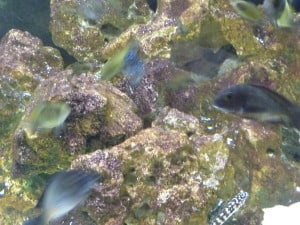Most fish will tolerate a broad range of pH, but for them to show their best colors, exhibit their most natural behavior, and possibly breed, adjusting the pH of the water they are going to live in may be necessary.
Adjusting the pH of your local water to match the conditions of the water in which the fish were raised is easy, but it can be tricky. Your local water chemistry, especially its buffering capacity, will determine how much chemical manipulation is required. Most importantly, you want to make pH changes before adding fish to the water. Fiddling with pH changes in fish tanks containing live fish is very dangerous and accounts for a large number of owner-induced fish deaths.
Purchase a good-quality test kit, preferably one with reagents that are marked with an expiration date. Testing the water with outdated reagents will give false results.
To increase the pH
For example, from 6.0 to 7.0 — use a sodium bicarbonate based solution.
You can also try adding rocks to the aquarium with a coral sand substrate as this will buffer the pH keeping it high.

To lower the pH
For example, from 8.2 to 7.6 — use a muriatic acid based solution.
The addition of wood such as bogwood will help to buffer the pH to a lower value naturally.

Regardless of whether you are raising or lowering the pH of your tap or well water, the key is to achieve a stable pH balance. If your water is highly buffered, you will discover that when you first begin to change the pH it will magically “bounce back” to its original level. This is the natural chemistry of the water attempting to stabilize itself at its original pH.
To create a new stable point, you should add a small amount of the appropriate chemical, sufficient to reach halfway to the desired pH level. Stir the water after each new treatment and wait one hour before taking a new pH reading. Once the water stabilizes for 24 hours at the halfway point, you can continue the procedure until reaching the desired pH.
You should plan to complete any pH manipulation at least one week prior to the arrival of the new fish. In addition, you should check the pH every day to ensure that it remains stable and doesn’t fluctuate.
API 800 Test Freshwater Aquarium Water Master Test Kit
Features:- Contains one (1) API Freshwater master kit 800, including 7 bottles of testing solutions, 1 colour card and 4 glass tubes with cap
- Helps monitor water quality and prevent invisible water problems that can be harmful to fish and cause fish loss
- Accurately monitors five most vital water parameters levels in freshwater aquariums: pH, High Range PH, Ammonia, Nitrite and Nitrate
- Designed for use in freshwater aquariums only
- Use for weekly monitoring and when water or fish problems appear
API pH UP Freshwater Aquarium Water pH Raising Solution 118 ml Bottle
Features:- Contains one (1) API pH UP Freshwater Aquarium Water pH Raising Solution 118 ml Bottle
- Raises freshwater aquarium water pH with a phosphate-free formula
- Does not promote algae growth with pH adjustments and is safe for plants and fish
- Slowly neutralizes acidic substances that cause low water pH
- Test water weekly and use to correct pH level in freshwater aquariums
API pH DOWN Freshwater Aquarium Water pH Reducing Solution 118 ml Bottle
Features:- Contains one (1) API pH DOWN Freshwater Aquarium Water pH Reducing Solution 118 ml Bottle
- Lowers freshwater aquarium water pH with a phosphate-free formula
- Does not promote algae growth with pH adjustments and is safe for plants and fish
- Slowly neutralizes alkaline substances that cause high water pH
- Test water weekly and use to correct pH level in freshwater aquariums





Related Posts
A Deeper Look In To Loach Fish Species
How Much Salt Should I Add To My Freshwater Aquarium
Everything You Need To Know About Using T5 Lights For Your Aquarium